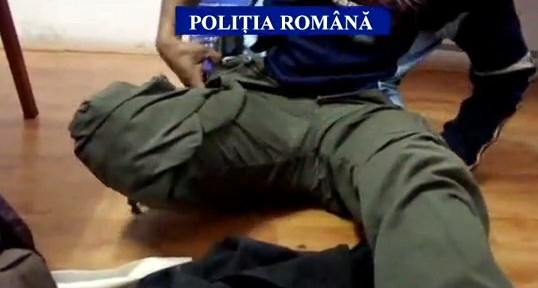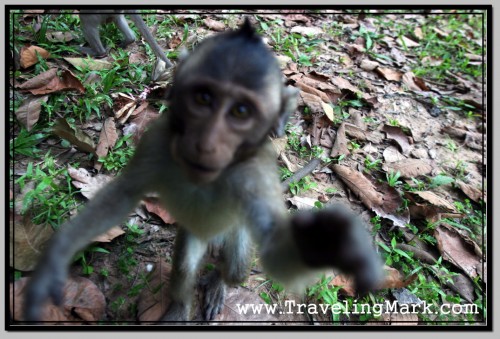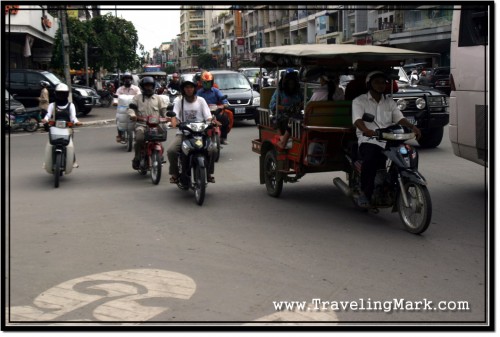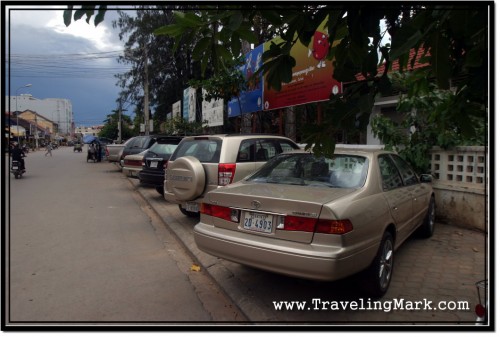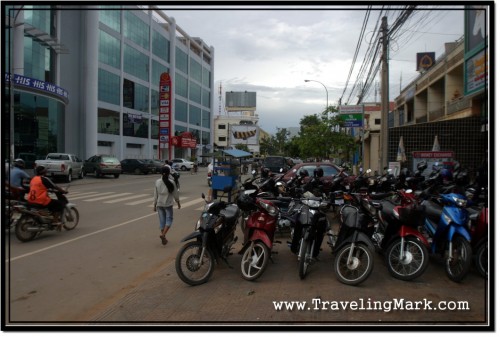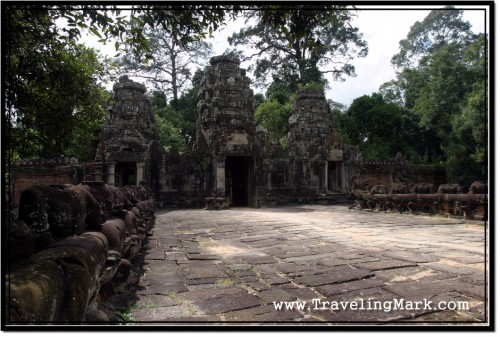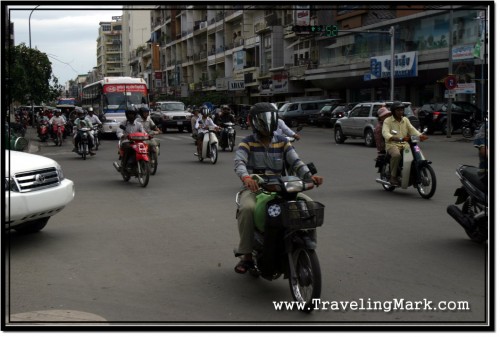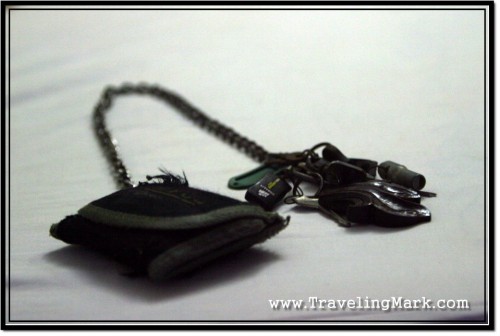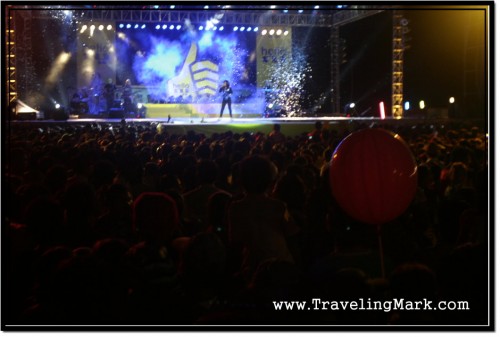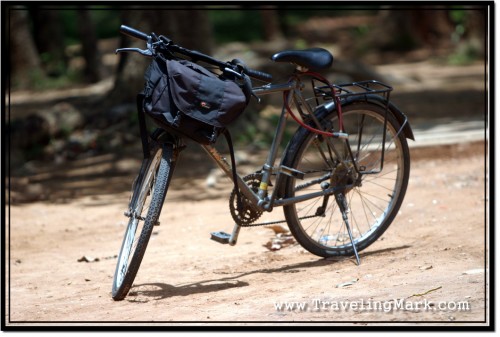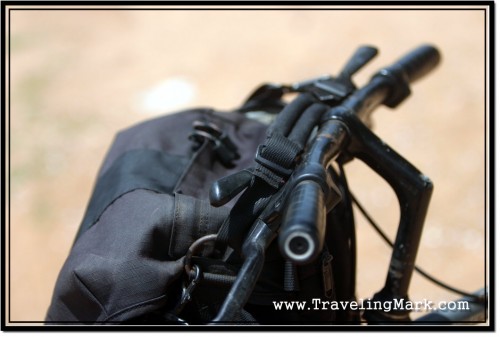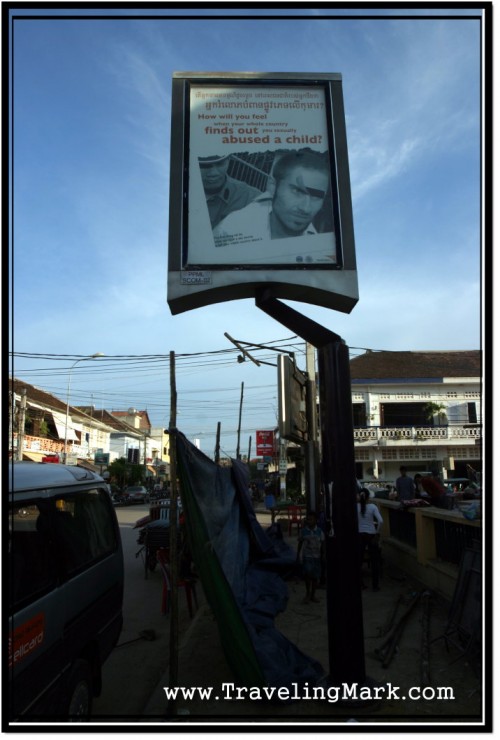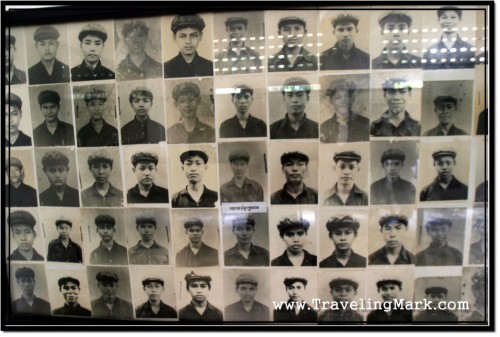Since I’ve been loudly and proudly referring to the dim-witted imbecile apologists as “sheep“, many contacted me angrily questioning how I came to conclusion that I wasn’t one. Nothing could be easier to prove, so let me get right down to it.
Sheep are dim-witted imbeciles. More than anything else, they lack the ability to see the forest for the trees. With their noses firmly glued to the ground, it’s no wonder they can’t see the plains that stretch far and wide. All they see are stems of grass that fill up their entire field of view. But somehow they believe that being this limited comes with a license to nag. So nag they do. The more limited their field of view, the louder they nag.
The issue of child sex tourism in Cambodia or an outlook on how cheap Cambodia really is are great examples of how lacking their wits are. If you focus on a raindrop that’s right before your face so much you can’t see the ocean that spreads before your feet, and use your limited wits to argue with everyone that your shiny raindrop is the largest body of water in the universe, then there is no better way to address you than by calling you a dim-witted imbecile. But nagging at anyone who dares to tell you that your raindrop is nothing compared to the ocean, just because the majority are as limited in their field of view as you are, makes you a sheep.
Gypsies in Eastern Europe
Another great way to show how limited minds of the dim-witted sheep are, is by talking about Gypsies from Eastern Europe. I spent substantial amount of time in Eastern Europe and had a fair share of experience with them, as well as with people native to those lands. As with pretty much every place I’ve spent a lot of time in, I found reports on Eastern European Gypsies by other travel bloggers not only misleading, but downright dangerous. If someone were to truly believe what other bloggers are saying and adjust their behavior accordingly, they’d be setting themselves up for a walk down a mine field.
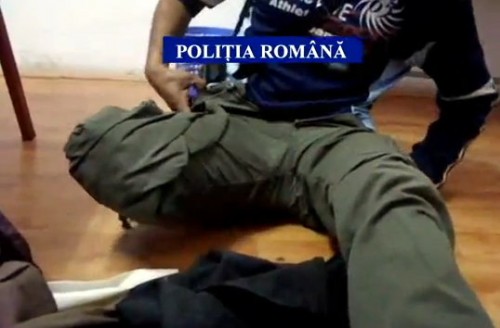
I don’t make a point at being politically correct – I make a point at being truthful. I’ve never downplayed anything and never offered half truths to avoid being called a racist, so let me do the same here. To put it bluntly – Eastern European Gypsies are incredibly dangerous, deceptive and always looking to take advantage of others. These nomadic people settled in Eastern Europe because it provided them with everything they needed to engage in a lifetime of crime and get away with it. Had it not been so, they would have moved on.
Generations of living at an expense of others made them expert whiners. They especially like whining to the sheep because sheep are many (significant majority) and lack the ability to see the forest for the trees so simple whinery is enough to fool them into believing that they are not criminals but victims. And guess what sheep do – I don’t need to tell you. You already know that by now.
Gypsies and Sheep
Sheep believe that presenting themselves as righteous warriors who fight for the rights of the oppressed somehow makes them god-like so they seek out the opportunities to prove themselves to other sheep. It’s sheepish to conform – individualism is frowned upon and usually results in exclusion which is what sheep fear the most. They forsake the ability to think for themselves and become expert brown-nosers, aka arse-kissers without a face who bleep when others bleep and jump in the well when others jump in the well.
There is only one thing that could possibly come out of a meeting between a dim-witted sheep and a professional manipulator. Sheep swallow every single bit of the fabricated story and spread the corrupted tale of it to the world. As a result, the ridiculous untruth about discrimination of Gypsies in Eastern Europe caught on and wrongfully painted Slavs as racist bigots. The very group of people who were the victims and themselves discriminated against became the target of international criticism all because wits-lacking sheep sided with manipulators. It’s the nature of the sheep to ignore the real issue if it lacks shock value (seen really well in the above described child sex tourism article).
There are many instances when I wish I could slap sense into a sheep, but when they take victims and label them racists, I just want to kick them in the nut-sack so hard they can’t bleep no more.
History of Gypsies in Eastern Europe
Would it surprise anyone to learn that history of the Eastern European (Slavic) nations is a history of peace? Slavs have always been non violent, hard working people who would rather sing folk songs and dance to beautiful music than march to war against another nation. This inherently non violent nature presented them with many challenges as other, more power hungry nations took them for an easy target, but it changed nothing on their desire to live in peace and grant the same to the others.
Anyone who’s ever worked with people from Eastern Europe can attest to how hard working they are. This can also be seen from how advanced and economically powerful countries like Czech Republic and Slovakia were before the 20th century world wars swept through their lands. Not even the UK could measure up to them at the time. And that’s despite thousand years of occupation and attempted elimination by the Magyars (Hungarians) who did everything in their might to erase their languages and identity from the pool of the living and turn them into Magyars.
This is the story of many Slavic nations – often attacked and oppressed for centuries, but never rising up to march against another sovereign nation to conquer it. They took to the arms when others tried to conquer them, enslave them or undermine their values, and through bravery and determination, they prevailed (sometimes with help from friends), but this only happened as a response to the outside aggression.
Then in 1968, Soviet armies moved in and instilled communist philosophies upon them. Private properties were turned public and everyone was guaranteed a house to live in and a job to earn a living with – unless of course they were found unable to work, in which case they would get monthly monetary support from the government. The government would also assist parents by awarding them child benefits for each child up to the age of 18 years old.
This worked reasonably well since Slavs are naturally honest and very hard working so everyone rolled up their sleeves and got down to work to help recover from the devastation caused by two major wars. Everyone except from Gypsies. These nomadic people saw the opportunity to get something for nothing so instead of moving from place to place like they’d done for centuries, they stopped where they were and started exploiting the system for their own benefit.
Since government paid so much money a month for each child a woman had, Gypsies started breeding in out of control numbers to get as much in child benefits as possible. And since government also paid for the disabled who were deemed unable to earn their own living even if job for them was guaranteed, they all started pretending they were mentally insane in order to avoid going to work but still have monthly income coming their way.
They would not entertain an idea of leaving Eastern Europe after it became apparent that they could get unlimited amounts of money if they just kept breeding and pretending they couldn’t work. So breed and pretend they couldn’t work they did and money kept coming. If they needed more dough, they just made more kids and voila – their monthly allowance increased.
As a result, Gypsies who didn’t spend one day working earned more money each month than Slavs who worked hard every day. You’d think these well funded Gypsies’d live in poshy palaces and wear finest clothes, given the money they got for nothing, but exact opposite was true. They took this money most Slavs who worked couldn’t even fathom and wasted it all within days on booze and drugs, leaving nothing for food or clothes for children.
Aside from looking slightly different owing to their ethnic background, Gypsies are also easily distinguishable from the Slavs by the fact that they always wear old and dirty clothes and their kids suffer from malnutrition. It’s not surprising that to the sheep, Gypsies would look poor, oppressed and neglected. Except that sheep never look below the surface because if they did, they’d see that Slavs, who always look clean, healthy and presentable earn less money than Gypsies get for nothing each month.
Most of the time, the real reason why kids of Eastern European Gypsies look so sick and dirty, and why they wear what looks like pre-war clothes with tears and holes on every fold, is because their parents never try to manage money properly and waste it as quickly as they get it. The use of the “Easy come, easy go” phrase has never been more appropriate. If Slavs can make it through the month with less money than Gypsies get and still look well taken care of, then there really is no excuse for Gypsies not to. But then again, unlike Gypsies, Slavs don’t own 20kg worth of golden chains and rings each.
Needless to say, what follows after all the monthly allowance was wasted is stealing. Both parents and their kids go out to look for supplemental income by robbing people who have to work for their money. Stolen money not only gets them through the weeks after their monthly allowance was wasted, it’s also a way to kill time. Since they don’t need to go to work, they have whole long days to look for something to kill boredom with and a little excitement victimizing natives has proven to go a long way. It also, at the same time satisfies their inbred itch to commit crime.
Gypsies are natural born criminals. They’ve stolen, pillaged, raped and murdered as part of their normal development for centuries, polishing the art of theft to perfection. And since Slavs are by nature non violent and hold a very negative stance on crime, they make for perfect victims. Faced with these professional criminals, the law abiding natives stand no chance.
Days of boredom on end allowed the Gypsies to form gangs and organize their attacks for maximum heist. Kids are often used as lures or agent provocateurs while whole mobs wait nearby to struck at the opportune moment. Heavily outnumbered, robbed victims are often beaten, or in the case of girls – raped. Not even children or seniors are spared. There is simply no line Gypsies wouldn’t cross.
Gypsies did not value anything they were given because it cost them absolutely nothing to get it. Government gave them houses for free so Gypsies destroyed them. Government gave them child support for breeding like rabbits so they wasted it all on booze and golden trinkets. And if anyone dared to stand up to them, Gypsies attacked every member of his/her family and threatened further violence should this be repeated.
The police were the once with the least leverage against Gypsies. It would be very rare for a crime to take place which was not committed by a Gypsy, but trying to bring any of the Gypsy perpetrators in resulted in whole gang of them coming together to complain to the international court that the arrest of their criminal friend was an act of racism and discrimination. They portrayed themselves as victims each and every single time making bringing them to justice virtually impossible.
Matters were further complicated by the fact that these huge Gypsy gangs would unleash unspeakable violence upon the family of anyone who would stand in their way. You lock one of them up and end up with five hundred of them setting your house on fire and beating your kids up to the brink of death.
However the biggest joke in all this are the sheep. All the while Gypsies oppress the majority and exploit their good will, they also take each and every opportunity to show off buildings they got new, but destroyed to let the sheep see what conditions they live in, they’d show their sickened, malnutritioned kids whom they haven’t fed because they wasted all their monthly allowance on drugs, but tell the sheep that their kids starve because nobody wants to employ them, and add a number of made up tales about someone attacking them because they were Gypsies and the sheep swallow it whole with cherry on top, get outraged and instantly label Slavs “racist bigots”. Could you believe the dumbness of those sheep?
Catch 22
Slavic nations opened themselves up to these people from afar, gracefully welcomed them among themselves but all they got in return was exploitation, abuse and crime. While the Slavs worked hard to keep the economy going, Gypsies beat little boys, raped little girls and robbed anyone they laid eyes on. 10% of population accounted for 90% of all crime committed but when anyone tried to point it out, they complained to the international court and the victims took the blame.
Gypsies utterly painted Slavs – some of the most peaceful people in the world – racist just to satisfy their ever growing greed and lust for criminal behavior. And how did the sheep respond? Unsurprisingly… by nagging and crying on behalf of those “oppressed Gypsies” whose life must surely be so incredibly hard in Eastern Europe. I mean, can you imagine never needing to spend a day at work and still get more money than any working man? And how about complete freedom to commit countless crimes and always get away with it because if they tried throwing you in jail, you’d scream “Bloody Racists” until the sheep trampled the system till you were freed?
Cause and Effect
It goes without saying that even the most peaceful nation, when pushed to the limit, would eventually stand up and say “enough is enough”. For 20 years of communist rule, Gypsies exploited peaceful, hardworking Eastern Europeans and never as little as said “Thank you”. Instead, they labelled them “racists” and framed them with lies of discrimination all the while their peers robed, raped and murdered the very people whose money they lived off of. Someone was bound to slam their fist on the table and attempt to put a stop to it.
When the police has their hands tied because each time they try to arrest a Gypsy, whole Gypsy community gangs up on them, threatens them with murder and violence against their children, and complains to the international court that they are racially targeted, then perhaps it’s time to look for solution outside of official ways.
The natural response was the spark of the Skinhead movement. Skins didn’t just come to exist because someone thought it was cool. They were a response of a nation to the exploitation by abusive invaders. Unwillingness of Gypsies to live lawful lives and respect others like others respected them forced oppressed individuals into retaliation.
It made sense – I mean, you can only rape someone’s sister, bully his brother and rob his parent’s so many times before he snaps and tells to himself: “That’s enough!”. Gypsies kept raping innocent girls, bullying innocent boys and murdering innocent workers for so long, something was bound to happen. And so the Skinheads came to be.
My Encounters with Gypsies in Eastern Europe
I visited High Tatras in Slovakia with an Australian girl I met in London, England. While we were there, minding our own business, we were abducted by a Gypsy looking to rob someone and draw blood. My companion was like all other sheep at first – she complained about racism towards Gypsies based on reports by fellow sheep, but when knife wielding Gypsy attacked us and threatened to kill us if we didn’t give him our possessions, she was forced to sober up and realize that the opposite was true.
There were people around, but since it was a Gypsy who attacked us, nobody dared to intervene. After decades of exploitation, people feared these criminals who operate in gangs and because they don’t go to school or work, they have whole days to improve on their gangster tactics. We were attacked within the train station in Poprad. There were people inside and we had hoped someone would come to our aid – but no one did. It was clear why.
We got off without being stabbed in just the last moment after the attacker ripped our bags we were trying to hold on to off. It was a terrifying experience and it wasn’t the only one. A few days later, in a public transport bus, a group of Gypsy kids boarded a packed bus and started pulling stuff out of people’s pockets. When confronted, the kids ganged up on the victim, spat on her, kicked her and threatened with violence. They always have bigger, stronger accomplices accompanying them so if anyone dared to not cooperate, they would get beat up.
Things like that kept happening absolutely everywhere and all the time. We saw groups of those Gypsies wandering the streets, always looking for trouble. During the day – when all locals were at work, Gypsies provoked lone, out of place individuals to pick fight with them. While all Slavic people were incredibly welcoming, peaceful and friendly, the feeling of safety was always gone when Gypsies were around.
And then we visited Bratislava, the capital of Slovakia. Without realizing why, the tensions we used to experience before were suddenly gone and entirely replaced by feelings of complete safety. A few days later we realized that since we came to Bratislava, we have not seen a single Gypsy. We no longer had to always look around us to make sure no Gypsy was after us, or to be aware where they are so we don’t look that way because they could consider it a challenge and respond to it by taking their whole gang that’s been sitting around whole day waiting for something exciting to spark it up and jumping us to see what “our problem” was.
After traveling through places populated with Gypsies, by whom we were threatened, attacked, robbed and several times near killed, a visit to a Gypsy free place was an incredible relief. Turned out that Skinhead movement was so strong in Bratislava, they cleaned their city off Gypsies and no new ones dare to come. The citizens had enough of being pushed around and victimized and stood up for themselves, forcing crime away from their city. The police couldn’t do it, so the citizens took their own safety into their own hands. That allowed us to embrace that notorious Eastern European hospitality and friendliness to the fullest.
After we’d left Bratislava, the danger returned. Never from the ranks of locals. Always from Gypsies. They had whole areas donated to them by the Communist governments in which they built them houses and parks but Gypsies destroyed them all. We passed by several Gypsy communities and could not believe our eyes. Buildings literally ripped to shreds, surrounded with up to a meter of garbage, all windows smashed, doors burnt with burn marks staining the walls, horrible smell everywhere, disease literally crawling all over – it was plain and simple disgusting and they turned it into this mess themselves, after it was donated to them new and free.
We could often see Gypsy areas built next to areas occupied by the Slavs. Same buildings, same size and style, clearly built at the same time, just one occupied by the locals, whilst the other by Gypsies. Buildings in which Slavs lived were clean and well maintained, buildings of Gypsies were ravaged, stripped to bare walls. There was this saying that what was not welded against something unmovable, it would have been stolen by the Gypsies.
Everything the government gave them was ripped into pieces. Showing zero respect for property, Gypsies stole or destroyed anything that could be stolen or destroyed. Then once completely destroyed and looking as if a nuke was dropped on the area, Gypsies would show it to the sheep while forcing fake tears out of their eyes with a claim that that’s how they are forced to live here. The fact that the building was provided to them in brand new condition and that it was them who destroyed it is somehow never mentioned and the sheep don’t ask. They just see a whiny Gypsy living in a disgusting house so it must be the result of discrimination of Gypsies by racist Slavs.
Occupation of Europe
Through criminal behavior and deception, Eastern European Gypsies are often incredibly rich. They promenade themselves in old, smelly, dirty clothes when sheep are around, but we got a chance to see a Gypsy wedding and I couldn’t believe how rich they really are. I was surprised they were able to walk with all these golden chains all over them. Must be a tough life for a Gypsy in Eastern Europe when all they own is $10 Million worth of gold jewelry each.
Another close look behind the veil of poor, discriminated faces of Eastern European Gypsies revealed an even more shocking surprise. Despite the fact that they never spent a day working for their money, many lived in incredibly poshy multi million dollar homes. Shortly after Velvet Revolution (end of Communism in Eastern Europe), they found out that Denmark and other Scandinavian countries had welcoming asylum policies and provided people who take advantage of it with more freebies than even communist governments did in Eastern Europe, so they rearranged their gang structures and spread the activities to other parts of Europe.
In order to be granted an asylum, they presented authorities with fabricated stories of discrimination in Eastern Europe and it worked. Foreign governments provided them with new accommodation, more money for nothing and daily rations so they could enjoy work free lives and focus on exploiting people beyond borders of Eastern Europe.
And so Gypsy gangs with international ties were formed and exploitation on much broader scale began. Seeing that deceiving people with begging tricks worked well, Gypsies from Eastern Europe whose numbers grew through out of control breeding (remember that they got so much money per child – the more children, the more free money) spread into every corner of the old continent pretending they were poor, sick, disabled or otherwise disadvantaged to get money from sympathetic citizen.
One Legged Gypsy Beggar
The video below was filmed by the Romanian police after they’d arrested a one legged Gypsy beggar. It’s Gypsies like this one legged beggar that cause sheep to cry “bloody racists” at Slavic people. Sheep simply can’t see past the tip of their noses so their response is to turn victims into bigots.
I call this beggar a “lying piece of shit” because that’s what he is but apparently, according to the sheep, calling a liar and liar is being a racist bigot myself, so that’s what they call me too. A liar Gypsy uses his race as tool of deception and sheep would jump down the throat of anyone who calls him out.
Good thing is – I know darn well how dim witted sheep are so being called a racist bigot by the lot of them is actually a flattery and a proof that I’m doing the right thing:
